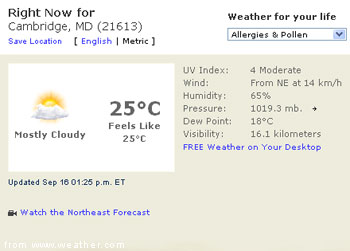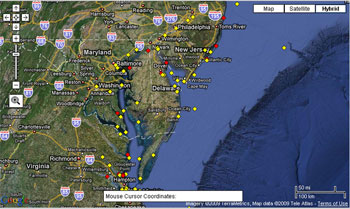 Introduction
Introduction
The circulation of the ocean’s waters described affects regional weather. Ocean water has high heat capacity that results in the rather slow temperature changes of the ocean in comparison to the low heat capacity of air that results in rapid changes in air temperatures. These two aspects of ocean circulation and heat capacity explain why the air temperatures in coastal locations are often cooler by the ocean in the summer and warmer in the winter than inland locations. The predominant wind patterns blow air affected by ocean surface currents to these coastal locations. In this exercise you will investigate the influence of the ocean by comparing temperatures in coastal and inland locations.
Objective
To assess how the ocean affects air temperatures.
Materials
- Computer with internet access
- Student Worksheet (optional)
Procedure
A. Finding the present air temperature.
Go to http://www.weather.com/
Type in your city and record the air temperature at this time: ____oC (click on metric under “Right Now for (your city)” to see the temperature in oC.
Locate a city by the ocean nearest you (on the same general latitude) and record the air temperature at this time: ____ oC
B. Finding the water temperature:
To find ocean water temperature, go to NOAA’s National Data Buoy Center http://www.ndbc.noaa.gov/
Zoom into a coastal area on the map nearest the coastal area you selected above.
Click on a coastal ocean buoy and scroll down to find the water temperature. Click on “View Details” and select Metric as the Unit of Measure.
Record the temperature value ____ oC
Compare your answer to the air temperatures you found in (A) above.
- Which area’s air temperature was the closest to the ocean temperature?
C. Finding the monthly average high and low temperatures.
Return to the weather conditions for your city at http://www.weather.com/
Scroll down to the “36 hour forecast” and click on “averages.”
Under the “monthly averages” menu, select “compare locations” and enter your ocean comparison city from (A) above and compare the average high and average low temperatures for the two cities.
- Which city had the highest monthly summer temperatures?
- Which city had the lowest monthly winter temperatures?
- What effect does the ocean have on coastal and inland air temperatures?
- Explain how the ocean affects local air temperatures.
